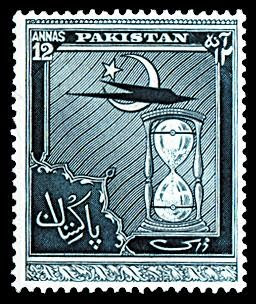 At the time of partition of the Indian sub-continent, India agreed to Pakistan\'s request to supply postage stamps and postal stationery dully overprinted PAKISTAN on Indian stamps of King George VI. Stocks of stamps in Treasuries under Pakistan jurisdiction were sent to Nasik Security Press, and after receiving overprint, the stamps were brought into use from October 1, 1947.
At the time of partition of the Indian sub-continent, India agreed to Pakistan\'s request to supply postage stamps and postal stationery dully overprinted PAKISTAN on Indian stamps of King George VI. Stocks of stamps in Treasuries under Pakistan jurisdiction were sent to Nasik Security Press, and after receiving overprint, the stamps were brought into use from October 1, 1947.Rupee values were in vertical shape with effigy of the King in an oval surrounded by decorated frame. The colour of the frame is give first in salient features.
The overprint was applied across the stamp in black, in lower anna values it is 13mm and on l4a and rupee values it is 19mm in length.





























































